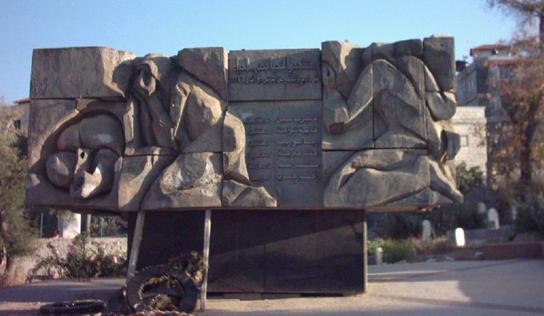Forty-two years ago, on March 30th 1976, mass demonstrations against the confiscation of Arab-Palestinians land by the Israeli government spread throughout the country, from the Galilee in the north to the Negev in the south. Six Arab-Palestinians were killed, over a hundred were wounded, and hundreds more were arrested. What became known as Land Day was the first large-scale general strike of Arab-Palestinians in Israel since 1948, and marked a watershed in the struggle of the Arab-Palestinian minority in Israel, those who remained within the boundaries of the state following the Nakba, for their rights and equality.

The monument in Sakhnin erected in memory of the six Arab-Palestinians killed during the first Land Day in 1976 (Photo: Wikipedia)
Today, Friday, March 30, the Palestinian-Arab minority in Israel will mark the 43rd Land Day beginning with a wreath-laying ceremony in the city of Arabeh in the Galilee at 15:00. The central messages of this year’s Land Day rallies will include condemnation of the racist policies of Benjamin Netanyahu’s government, a call for the expansion of the municipal boundaries of Arab communities, and the demand that master plans be approved for these communities to alleviate the severe housing shortage among Arab-Palestinian citizens of the state.
At 13:00, a mass demonstration will also be held at “Raas Jaraba” east of Dimona in the Negev. Tomorrow, Saturday, March 31, a demonstration against land confiscations will be held in fields of Al-Roha, near the city of Umm al-Fahem in Wadi Ara, at 14:00. In the occupied West Bank and Gaza Strip, as well as in the Palestinian refugee camps in Lebanon, solidarity demonstrations will also be held today, Friday.
In 1976, the government of Israel declared its intention to expropriate lands in the Galilee, affecting some 20,000 dunams of land between the Arab cities of Sakhnin and Arabeh, of which 6,300 dunams were privately owned by Arab residents of the area. On March 11, 1976, the government published the expropriation plan.
The governmental decision to confiscate the land was accompanied by the declaration of a curfew to be imposed on the villages of Sakhnin, Arabeh, Deir Hanna, Tu’ran, Tamra and Kabul, effective from 17:00 on March 29, 1976. Following a decision by the Central Committee of the Communist Party of Israel, local Arab leaders called for a day of general strikes and mass protests against the confiscation of lands on the following day, March 30. The mayor of Nazareth, the communist Tawfiq Ziad, was among the local Arab leaders who made such a call.
The government declared all demonstrations illegal and threatened to fire from their jobs any “agitators,” such as schoolteachers, who encouraged their students to participate. However, the threats were not effective, and many teachers led their pupils out of the classrooms to join the general strike and marches that took place throughout the Arab towns in Israel.
Once again, during the demonstrations that took place on that March 30 forty-two years ago, 6 Arab-Palestinians were killed, over a hundred were wounded, and hundreds more were arrested. In the wake of the first Land Day, in 1977 the Communist Party of Israel and other progressive forces founded the electoral movement Hadash, the Democratic Front for Peace and Equality which has been active ever since and which, in 2015, was instrumental in the founding of the Joint List.


